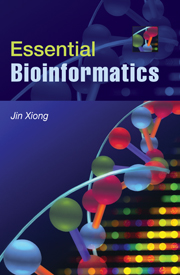Book contents
- Frontmatter
- Contents
- Preface
- SECTION I INTRODUCTION AND BIOLOGICAL DATABASES
- SECTION II SEQUENCE ALIGNMENT
- SECTION III GENE AND PROMOTER PREDICTION
- SECTION IV MOLECULAR PHYLOGENETICS
- SECTION V STRUCTURAL BIOINFORMATICS
- SECTION V GENOMICS AND PROTEOMICS
- 17 Genome Mapping, Assembly, and Comparison
- 18 Functional Genomics
- 19 Proteomics
- APPENDIX
- Index
- Plate section
- References
17 - Genome Mapping, Assembly, and Comparison
Published online by Cambridge University Press: 05 June 2012
- Frontmatter
- Contents
- Preface
- SECTION I INTRODUCTION AND BIOLOGICAL DATABASES
- SECTION II SEQUENCE ALIGNMENT
- SECTION III GENE AND PROMOTER PREDICTION
- SECTION IV MOLECULAR PHYLOGENETICS
- SECTION V STRUCTURAL BIOINFORMATICS
- SECTION V GENOMICS AND PROTEOMICS
- 17 Genome Mapping, Assembly, and Comparison
- 18 Functional Genomics
- 19 Proteomics
- APPENDIX
- Index
- Plate section
- References
Summary
Genomics is the study of genomes. Genomic studies are characterized by simultaneous analysis of a large number of genes using automated data gathering tools. The topics of genomics range from genome mapping, sequencing, and functional genomic analysis to comparative genomic analysis. The advent of genomics and the ensuing explosion of sequence information are the main driving force behind the rapid development of bioinformatics today.
Genomic study can be tentatively divided into structural genomics and functional genomics. Structural genomics refers to the initial phase of genome analysis, which includes construction of genetic and physical maps of a genome, identification of genes, annotation of gene features, and comparison of genome structures. This is the major theme of discussion of this chapter. However, it should to be mentioned that the term structural genomics has already been used by a structural biology group for an initiative to determine three-dimensional structures of all proteins in a cell. Strictly speaking, the initiative of structural determination of proteins falls within the realm of structural proteomics and should not be confused as a subdiscipline of genomics. The structure genomics discussed herein mainly deals with structures of genome sequences. Functional genomics refers to the analysis of global gene expression and gene functions in a genome, which is discussed in Chapter 18.
GENOME MAPPING
The first step to understanding a genome structure is through genome mapping, which is a process of identifying relative locations of genes, mutations or traits on a chromosome.
- Type
- Chapter
- Information
- Essential Bioinformatics , pp. 243 - 260Publisher: Cambridge University PressPrint publication year: 2006



